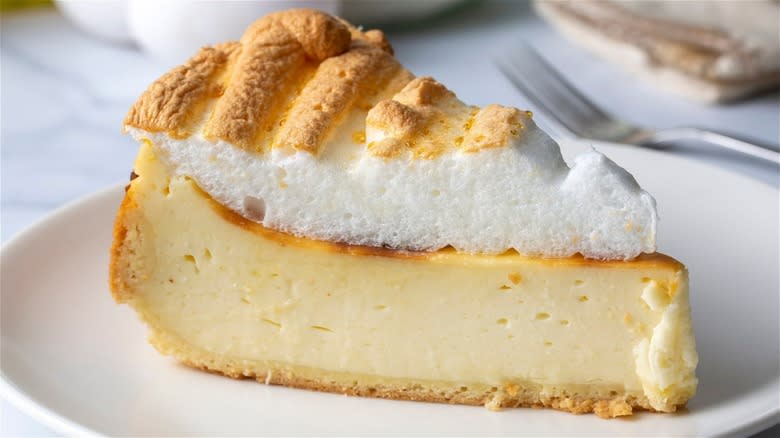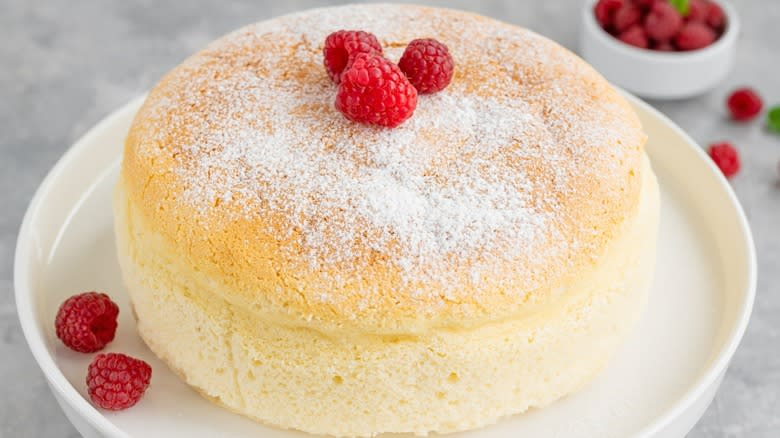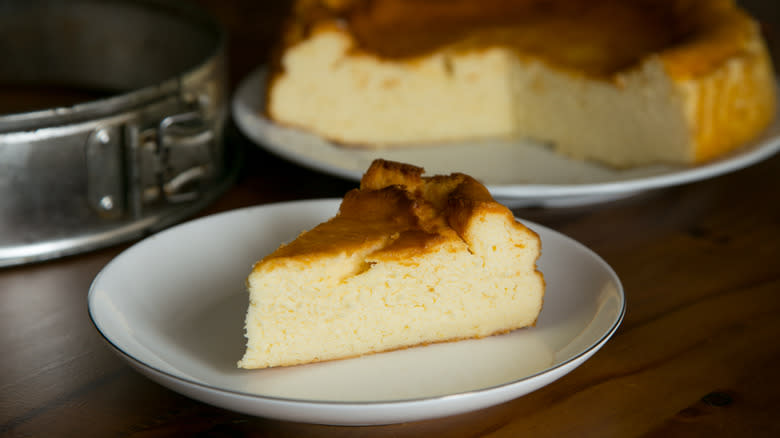Japanese Vs German Cheesecake: What's The Difference?

Rich, creamy, and packing a mouthful of luscious textures, cheesecake is one dessert that ranks high for foodies with a sweet tooth. When the craving surfaces, Americans typically think of the dense smoothness of the widely popular New York-style cheesecake. It's a beloved classic that originated around a century ago, but its predecessor features a contrasting light and fluffy consistency, resembling more of a traditional cake. This is one of the main differences between regular and New York-style cheesecakes, the latter tasting much heavier due to the addition of cream cheese. If there was a cheesecake spectrum, international versions of this dessert fall somewhere between the two. Japan and Germany are two countries that each have their own unique, delicious cheesecake recipes that differ from ours across the pond.
Biting into a Japanese cheesecake hardly requires any chewing, since the sponge is so miraculously soft that it just melts right in your mouth. They can be eaten cold as well as warm, and you can often find them packaged as bite-sized snacks at local Asian markets. On the other hand, German cheesecakes lean a bit more towards the American kind in terms of mouthfeel, but are lighter and made with a specific, creamy European cheese that can be difficult to find in the U.S. Both have intriguing flavors that would make any cheesecake lover want to let their taste buds branch out and try something new.
Read more: 12 Popular Ice Cream Brands, Ranked Worst To Best
What Is A Japanese Cheesecake?

Commonly known as cotton or souffle cheesecake for its delicate, cloud-like texture, when you first try a Japanese cheesecake, you'll be wondering what culinary magic it could possibly be laced with. The fluffiness is partly achieved by whisking egg whites separately before adding them to the batter, much like that of airy meringue. After mixing in the other main ingredients of cream cheese, butter, sugar, and heavy whipping cream, the cotton cheesecake is then baked in the oven using a special baking method.
The secret of the Japanese cheesecake's consistency lies in the bain-marie, a French technique that translates to "water bath", but western bakers might know it better as a double boiler. The bain-marie cooks the cake uniformly in the oven until its edges have firmed up slightly. It's traditionally topped with a tangy apricot jam or glaze once it's ready to eat. Not only is it significantly lighter than New York-style cheesecake, it also contains much less sugar. In the end you're left with a great balance of flavor and feel, without having to put down your fork because it's too rich.
After World War II, Japan got to experience American cheesecake for the first time as soldiers brought new cheeses with them into the country, but the Japanese souffle cheesecake didn't become what it is today without help. Japanese chef Tomotaro Kuzuno was inspired by the German cheesecakes on his travels to Berlin in the 1960s, which ultimately led to its inception.
German Cheesecake's Star Ingredient Is Quark Cheese

Depending on where you are in the world, cheesecake might go by a different name. In Germany, it's known as kasekuchen, and it's infused with a soft cheese made from soured milk that can be eaten in a variety of tasty ways. Not much is known about the kasekuchen's origins, just that it's existed in Europe since at least the 17th century. It's made with quark, a low-fat type of cottage cheese created very similarly to creme fraiche, although it tastes more like yogurt. When baked into a cheesecake, quark delivers a savory taste and gives the kasekuchen a lighter quality than that of American cheesecakes. Outside of German delis, specialty shops, and the occasional lucky score from a grocery chain, it can be challenging to find some quark cheese in the States, but you can substitute it with ricotta.
German cheesecakes don't boast any fancy ingredients. In fact, the recipe keeps it quite simple with just eggs, milk, and sugar as the necessary basics. It never hurts to include a dash of lemon zest or vanilla extract, as is also the case for many other sweet treats that might be on a baker's radar. It's common to enjoy a kasekuchen with fresh berries on top or to mix them with the quark cheese for a fruity cheesecake filling. Instead of the crumbly cookie layer featured in most western cheesecakes, it has a shortbread crust that gives this perfect cheesecake crust a bit of crunch.
Read the original article on Mashed.

